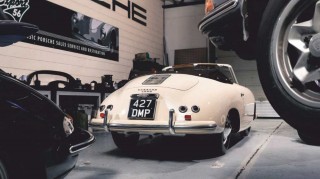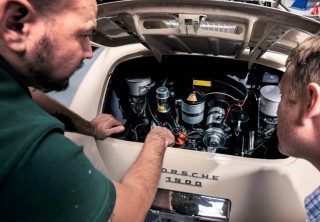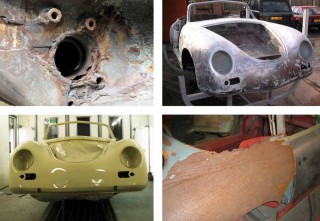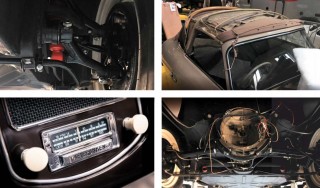Extreme Porsche 356B resto
Epic Restoration The painstaking resurrection of an incredibly rare right-hand-drive Porsche 356 Pre-A Cabrio
It had been bought and sold several times after restoration work had started,’ says Mick Pacey. ‘Imagine what that leaves you with.’ Pacey’s business, Export 56, has been restoring classic Porsches for 25 years. But these early ‘Pre-A’ 356s sport a variety of items that were used for only a single model year, and even a wealth of experience can’t create hen’steeth spare parts from thin air. So how did they end up taking on such a task? The car’s owner Brian Easton, can explain.

‘I saw a 356C belonging to a man I know through a car club, and I thought it was lovely. Once you’re aware of something like that, you start noticing them everywhere, and I decided what I wanted was an early right-hand drive 356 Speedster.’ Easton enlisted Mick Pacey to help in the search. He explained how difficult Pre-A Speedsters are to find in right-hand drive, and though they managed to bid on one example in an auction in London, they missed it. Then an alternative presented itself.
Before Export 56 took over, it had already seen much work – here it is in the early 2000s.
‘I was offered this pre-A cabriolet,’ says Pacey. ‘It was an incredibly rare car, and as a genuine right-hand-drive example it would have considerable value when it was finished. But I needed to be sure it was the right choice for Brian.’
Easton is amused as he recalls Pacey’s polite warnings about early 356s. ‘He knew I’d had fast cars – I’ve got a Ferrari 512BBi – and tried to explain how awkward and slow a 1500cc Pre-A would feel. But I’ve also got a 1929 Bentley and I can promise you that’s a lot more awkward to handle!’
Still, finishing someone’s abandoned project, finding every missing part and correcting every error was a big commitment. The first step was going to involve some detective work… step forward Chief Inspector Pacey.
Names and Numbers
‘Not many people can restore a 356 bodyshell properly,’ says Pacey. ‘There isn’t a straight line on them. Panel gaps are crucial and doing it right becomes very time consuming – on a really poor bodyshell you can spend £50,000 plus before you even get to paint. In the UK, there’s just a handful of names I’d trust, and one of those is Bruce Cooper at Sportwagen in Essex. So it was a big relief when I discovered the metalwork had been done by Bruce and his team.’

That suggested the car would indeed be worth finishing, but there’s another factor that’s gained importance throughout the classic car market, particularly the Porsche segment – matching numbers. Locating the original engine, not part of the package when Pacey first heard of the car, would be crucial.
The Pre-A was being sold by another 356 specialist, PR Services in Billericay, Essex. According to PR’s Paul Smith, ‘The car lost its original engine maybe 25 years ago. More recently, while buying a load of old oily 356 parts, I stubbed my toe on an early engine case.
‘I took no notice of it at the time and it was thrown in on a deal for other stuff that I had an interest in. When I got around to checking the number it seems that karma was on our side – it was the original engine!’ With this good news in hand, Pacey was able to offer the Cabrio to Brian Easton as a numbers-matching project with some decent provenance. All straight-forward from here, then? Don’t you believe it.
Filling in the gaps
It’s more than 20 years since Bruce Cooper first saw this Cabrio, and he works with 356s every day. Yet he calls the job to mind straight away, ‘A customer of mine brought it to me in late 1997.

‘He’d bought it as a running car from AFN, the Porsche distributor in Guildford, but wanted it restored to as-new condition. That was always going to be a huge job, but we agreed and got stuck into it.’
The car was stripped and sent for blasting and what came back was what Cooper feared – ‘pretty shoddy, with rot that was reasonably extensive… but not a complete basket case.’
Photos taken at the time show how Sportwagen’s staff stripped the car of its front panels and then of its entire front substructure – a later item fitted in 1962 by the Porsche dealer following an accident – and firewall too, with numerous repairs to A-posts, B-posts, rear wings and scuttle, floors and support pieces. It’s no surprise to hear Cooper’s account of the time spent. ‘We put 835 hours into that bodyshell. That’s not all that much for a full rebuild of one of these by modern standards, but back then they were worth as fraction of what they are now.’
Pacey agrees, putting the value of this car at around £35k when that huge investment was made.

‘By 2000 or 2001, the original owner clearly felt it was getting too serious,’ says Cooper, ‘so he bailed out and sold it at a loss after we’d finished the ’shell. It was lead-loaded, prepped and painted, but there was plenty left to do before it would be a car again.’
From here, the Cabrio changed hands at least once more, becoming part of a collection that included many other classic Porsches, all of them ahead of this one in the queue for restoration. Hence it remained in storage, getting no worse but making no progress either, until the decision was taken to pass it on. But would Easton and Pacey agree on an approach for the rest of the job?
A friendly battle
In the spring of 2016, the team started a full audit of everything that arrived while Mick Pacey and Brian Easton began discussions on the project’s direction.
‘Everything Brian said, I disagreed with,’ laughs Pacey. ‘I said “it’s my car, not yours,” and although I was joking I did feel I should push the restoration of such a rare car in a pretty specific direction.’

He eventually persuaded Easton to stick with the original Pearl Grey with chocolate brown leather, as per Porsche’s Kardex specification. ‘The car had a red Eighties reproduction interior with it when we acquired it,’ says Easton. ‘While it was always going to be replaced, I quite fancied the red with silver paint. But Mick persuaded me to stick with the Kardex for the paint colour, so it made sense to do so for the interior too, which led to the same choice for the hood… and the history of the car took over.’
Dean Dallison built up a later 1600cc 356 engine after owner Brian Easton chose to preserve the matching-numbers original. After initial paint-stripping, the outer panels looked okay but hid much trouble beneath. Torsion-bar aperture in rear chassis leg had been bodged, patched and bodged again. Pearl Grey is neither pearl-coloured nor grey, but it is a genuine pre-A colour. Arch and sill closing section cut off while rusty top edge awaits the same treatment.
Mick Pacey explains how ultra-rare parts were sourced while keeping costs modest – in relative terms of course. An incorrect substructure replacement in period caused a major roadblock with the steering angle. The hood’s existing metal rails and springs were joined by new ash sections and Bakelite spacers. Correct Telefunken radio cost £6000. New wiring loom was standard 356, modified to accommodate Pre-A’s push-button starter.
‘The history was really interesting,’ says Pacey. ‘This car was finished on the 29th of April 1955 and sold on the 29th of October that year by AFN, then in Isleworth. John Aldington, later managing director of AFN and then of Porsche Cars GB, remembered it as the first car he ever sold as a young salesman.’
Brian Easton had gone with Mick Pacey’s views on keeping the car’s colour and trim to original spec, but he was concerned about the engine.
‘Mick was keen to reunite the original engine with the car, but I always planned to drive it and use it properly when it was finished. If that valuable engine explodes in the process, we’re in trouble. So it’s packed away in my garage and will be kept safe. I actually won that argument!’
Instead, Export 56’s Dean Dallison identified a suitable 1600 engine to install for a cost-effective sum, giving more power for use in modern traffic without needing any irreversible changes to the car.
‘I stripped it and assessed the condition of the cylinder head and barrels, and sure enough everything was sound and worth building up,’ he says. ‘The biggest job was stripping and refinishing all the tin-ware. About 80% of the engine is covered by shrouds and other tin-ware to guide the airflow. Without the correct high-gloss finish it looks scruffy.’
While the engine wouldn’t pass for a 1500cc original, it had to look correct for what it was. The right air filters with German script stamped into them are a startling £400 each, and even the stickers are important. ‘We can get reproductions now,’ says Dallison. ‘There’s one to show tappet clearances, there’s that Bosch one on the coil that should always be upside-down and there’s a Fram one that tells you the part number for the oil filter. I even found an original-spec fanbelt that shows a Porsche logo.’
Restoration by email
‘I reckon 30-40% of the hours spent on this restoration consisted of research or parts hunting,’ says Ben Pacey, Mick’s son and Export 56’s head of sales and marketing. ‘You could go even further than we did, which was pretty far, but you have to know when to stop. We didn’t have a blank cheque.’
Nonetheless, Export 56 sourced as many of the uniquely pre-A pieces as they could hope to find, but on occasion had to resort to commissioning custom-made replacements. One door striker needed to be 3D-printed and the sun-visors are reproduction pieces made to precisely the right shape and colour with tinted, strip-bent Perspex and brass. They cost £2000. The fuel tank was doing its job, would have been invisible to anyone who saw the finished job and yet was wrong, so a correct pre-A item now rests there.
‘Sometimes, even finding the right part left us with an issue,’ says Ben Pacey. ‘The refurbished gauges look great but the contrast between the old control knobs on the dash and the new ones we sourced is quite noticeable. But what do you do? Throw away the originals? Spend even longer searching for old ones with matching patina? You have to draw a line.’
Some items, such as the rear reflectors or numberplate light box, eluded capture at the time but have since become available, such is the wave of interest in pre-A 356s. However, some remain extinct, so Pacey’s team had to fettle and fight the original aluminium over-riders until they consented to resting square on the bumpers.
That sinking feeling
Export 56 rebuilt the running gear; stripping, repairing and repainting suspension and steering components, identifying any interlopers that found their way into that pile of boxes – such as 356A brake drums, not pre-A – and replacing them with the correct items. With the tall, narrow 16in wheels bolted on, the bare ’shell became a rolling ’shell. And that’s when the awful moment occurred. As Export 56’s Richie Lawson recalls, ‘The steering refused to turn from lock to lock. The wheel would give you enough turns to the left but only a quarter turn to the right. I assumed something must be badly bent and measured the steering alignment… which was spot on. Then we noticed the right-hand steering arm was binding hard on the side of the hole in the bodyshell it was supposed to be passing through. The holes were in the wrong place.’
Almost two decades earlier, a new-old stock front substructure of the correct pre-A type was fitted to replace the later-type 1962 repair. It now seems that this item was intended for a left-hand-drive 356, though it would have appeared identical apart from the removable panel that allowed access to a right-hand drive steering box. This had duly been changed and as far as anyone could tell, the repair was completed to a high standard.
However, right-hand-drive pre-A 356s are things that specialists rarely see, much less measure, so one difference caught everyone on the hop. Explains Lawson, ‘The apertures for the steering arms are slightly different left and right depending on which side the steering arms are moved from, and the car had already been painted and undersealed long ago.’ Simply enlarging the hole was never an option if it was to be fixed properly. Instead, Lawson masked every painted surface and then cut out that inner wing panel on each side of the car, taking the adjacent pressing line with him and swapping them over so it would be indistinguishable from a factory right-hand-drive structure when re-welded and finished.
Trim to finish
If there was one relatively straightforward phase of the parts-sourcing process, it was buying interior coverings. ‘Autos International in California make seat cover and carpet sets for 356s,’ says Mick Pacey.
‘The seat covers in the right grain of chocolate brown leather come as a kit, and they’re even able to supply the correct heavy weave for the carpet, in just the right shade. We had some rubber floor mats made up to finish the job.’

Before the new leather covers could be fitted, Dean Dallison had to discard the rusty, broken springs and decomposing horsehair, leaving just the frames and hinges. These were duly re-chromed and re-sprung, then built up by the team with foam and horsehair internals. That just left the hood, perhaps the most fiddly job of all, as Dallison recalls.
‘The hood frame is pretty basic but it’s all handmade, with a mixture of steel pieces that get bent, wood pieces that rot, and Bakelite spacers and washers that go hard and crack.
‘I remade the wooden pieces in ash, and as we assembled everything we could straighten the metal rails. I fitted new spacers made from a more fibrous Bakelite, but the trickiest job was the springs.’
The hood mechanism is balanced against a large spring inside each rear quarter, held under considerable tension. Explains Dallison, ‘You have to grab them with mole grips and use brute force to heave them over the fixings because there’s nothing you can lever against.’
But before handing the job of covering the frame over to a specialist trimmer, Dallison and Pacey had another problem to solve. ‘They wanted to use aluminium tack strips to secure the hood to the bodywork, and to the front rail, but we vetoed that – they were non-original, flimsy and ugly,’ says Dallison.
‘The original trims are impossible to find,’ explains Pacey. ‘I measured and drew those on a car I saw at Pebble Beach. We made some with slim brass bar, shaped to fit, polished and nickel plated. But attaching them wasn’t straightforward either.’
Dean Dallison knew that the piece of ash frame inside the rear scuttle varied considerably in thickness, and he was reluctant to send a nail right through it and out the other side. ‘I estimated the thickness at each fixing point, cut the pins to suit and carefully tacked the trims in place. Got every one right first time!’ With the Cabrio over the finishing line, Brian Easton has got the Porsche he wanted – and the one Mick Pacey wanted too, it seems.
‘Mick always fancied the car himself, I reckon,’ says Easton. ‘When someone stands there with a Kardex and that much passion, it’s difficult to persuade him to do it in yellow with green seats! But I appreciate the car for what it is, and now I won’t even change the original tall wheels to give me a better choice of tyres. I want to take it to Munich in the summer and maybe into the Alps, but it is what it is – an old car and a steady driver. I won’t go tearing round corners!’
Thanks to perseverance, experience and a dose of good karma, this historic Porsche – believed to be one of just two surviving 1955 right-hand-drive Pre-A Cabriolets left in the world – should now have a future as long as its colourful past.
Owner Brian Easton wanted silver with a red interior, but was persuaded to go original.
MY FAVOURITE TOOL
Exhaust nut spanner
‘Believe it or not, these actually come with new exhaust pipes for classic 911s and 356s now,’ says Dean Dallison. ‘The job is impossible without one because the nut is totally obscured by the pipe and there’s no access to get a normal spanner in there. I’ll be making another one to do 13mm nuts as well as 12mm just so we can cover every Porsche in the garage.’
High point
‘When the hood went on. It finished the job with such quality that you looked at all the work that went into the car and just thought… ”yeah!”’ Brian Easton
Low point
‘The day we discovered the car had been fitted with a left-hand drive front end. It was fixable, but it was still a horrible moment.’ Richie Lawson





